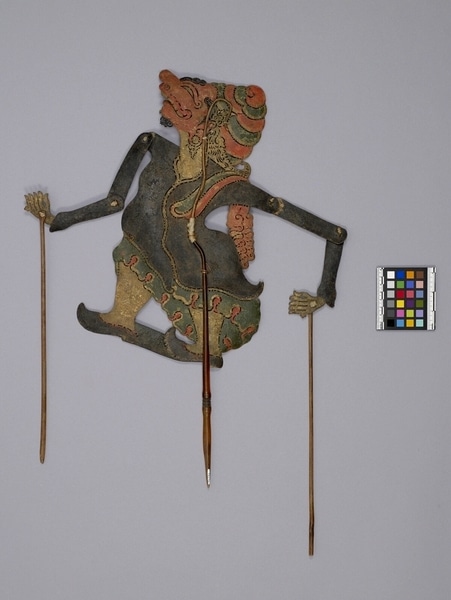Shadow Puppet Item Number: Ib272 from the MOA: University of British Columbia


Description
Shadow puppet depicting male figure with handle that splits just below the feet and extends up the body of the puppet on both sides, to the face. Moveable arms, each with a control rod attached. Linear detail of clothing and face perforated through the skin. Red and green songkok, gold-leaf sumping, red face, long eyes upturned, large nose, thin moustache, black tunic and shoes, green and red sarong. Wrists are flexed.
History Of Use
Javanese puppet theatre as an art form probably developed by the 11th century. The two-dimensional wooden wayang kulit puppets of Javanese religious shadow playss preceded the later and less sacred wayang golek puppets which appeared during the 16th century. Originally the plays depicted Javanese mythology, but after the Indian conquest of Java the Hindu epics, Ramayana and Mahabharata, were incorporated into the cycles, which comprise about 200 plays. The wayang kulit sacred shadow plays form is thought to have originated in southern India; the wayang golek puppets are indigenous adaptations. Although the prototype wayang kulit puppets are the older form, many symbolic elements remain the same. The shadow playss are performed by a dalang (puppet master) who is more formally a priest. An individual or group requests a dalang to celebrate important occasions. The performances often last all night and are generally presented in three acts, with vocal and instrumental accompaniment. The individual plays vary widely in detail but usually involve conflict between good and evil. They serve a moral and religious purpose, and more recently, one of political commentary. Each puppet's character is represented by its appearance and placement onstage; protagonists with strong elements of good are placed to the right, antagonists of violent or evil nature to the left. Most plays are based on the Mahabharata cycle conflict between the families of Pandawa and Kurawa. The main Hindu gods Vishnu, Shiva, and brama do not normally appear in the plays, but use a group of lesser deities, betara , as agents. These deities and resi can aid the retinues of either side. Betara Narada provides information to protagonists not otherwise available. Although he appears on the right, his actions are not necessarily in the interest of the Pandawas.
Cultural Context
Theatrical performance.
Iconographic Meaning
Figure is a deity (betara) or priest (resi). This puppet may be a priest; but it has some characteristics of Betara Narada (an aspect of Shiva): rose face, upturned eyes, long nose, small beard and close-fitting jacket. Sarong and eye shape unusual for Narada, but his form is somewhat variable. Betara Narada is a celestial messenger in Mahabharata plays.
Item History
- Made in Java, Indonesia
- Owned by Tradewind Antiques before March 15, 1983
- Received from Museum of Anthropology Shop Volunteers (Funding source) and Tradewind Antiques (Seller) on March 15, 1983
What
Who
- Culture
- Javanese
- Previous Owner
- Tradewind Antiques
- Received from
- Museum of Anthropology Shop Volunteers (Funding source) and Tradewind Antiques (Seller)
Where
- Holding Institution
- MOA: University of British Columbia
- Made in
- Java, Indonesia
When
- Ownership Date
- before March 15, 1983
- Acquisition Date
- on March 15, 1983
Other
- Condition
- fair
- Accession Number
- 0886/0006